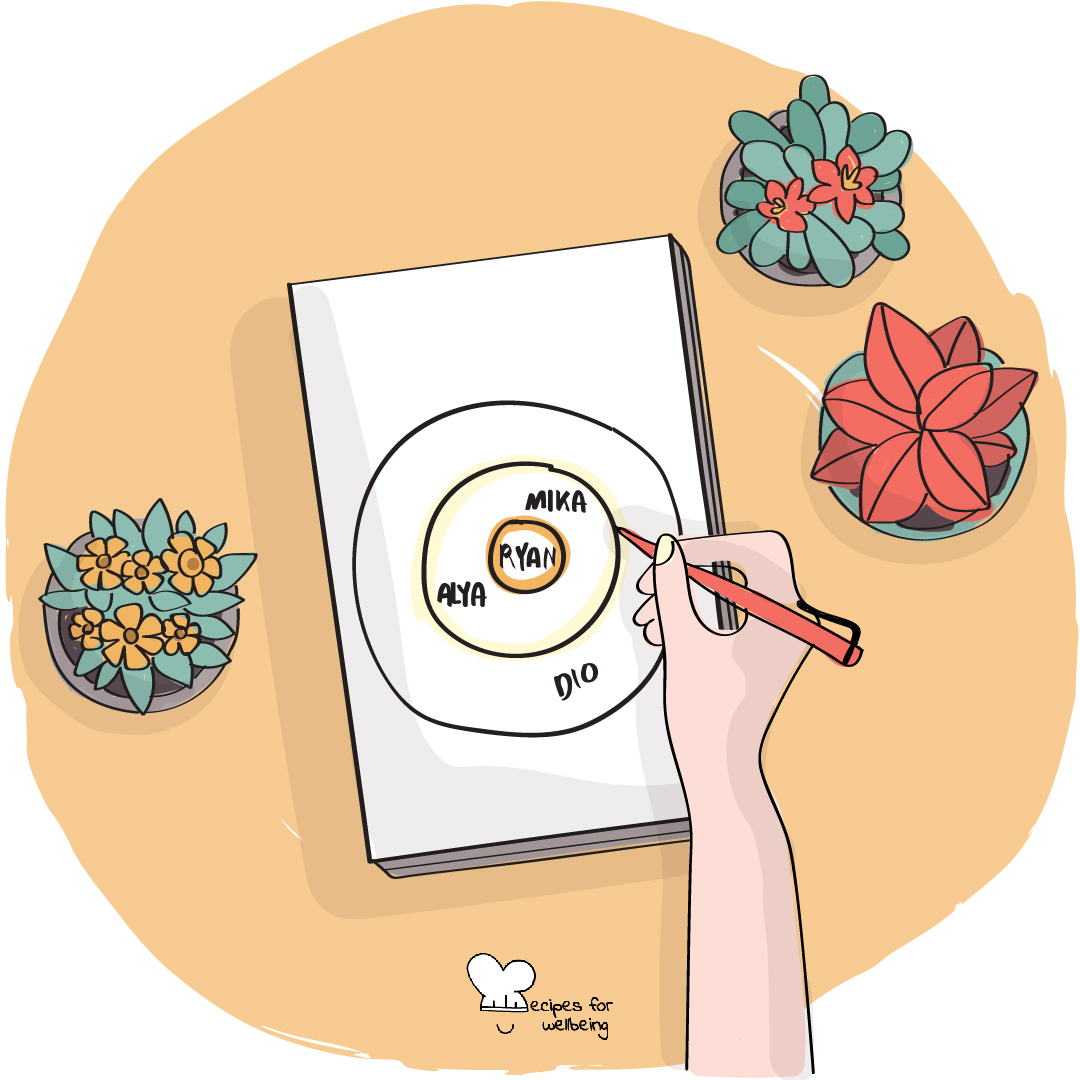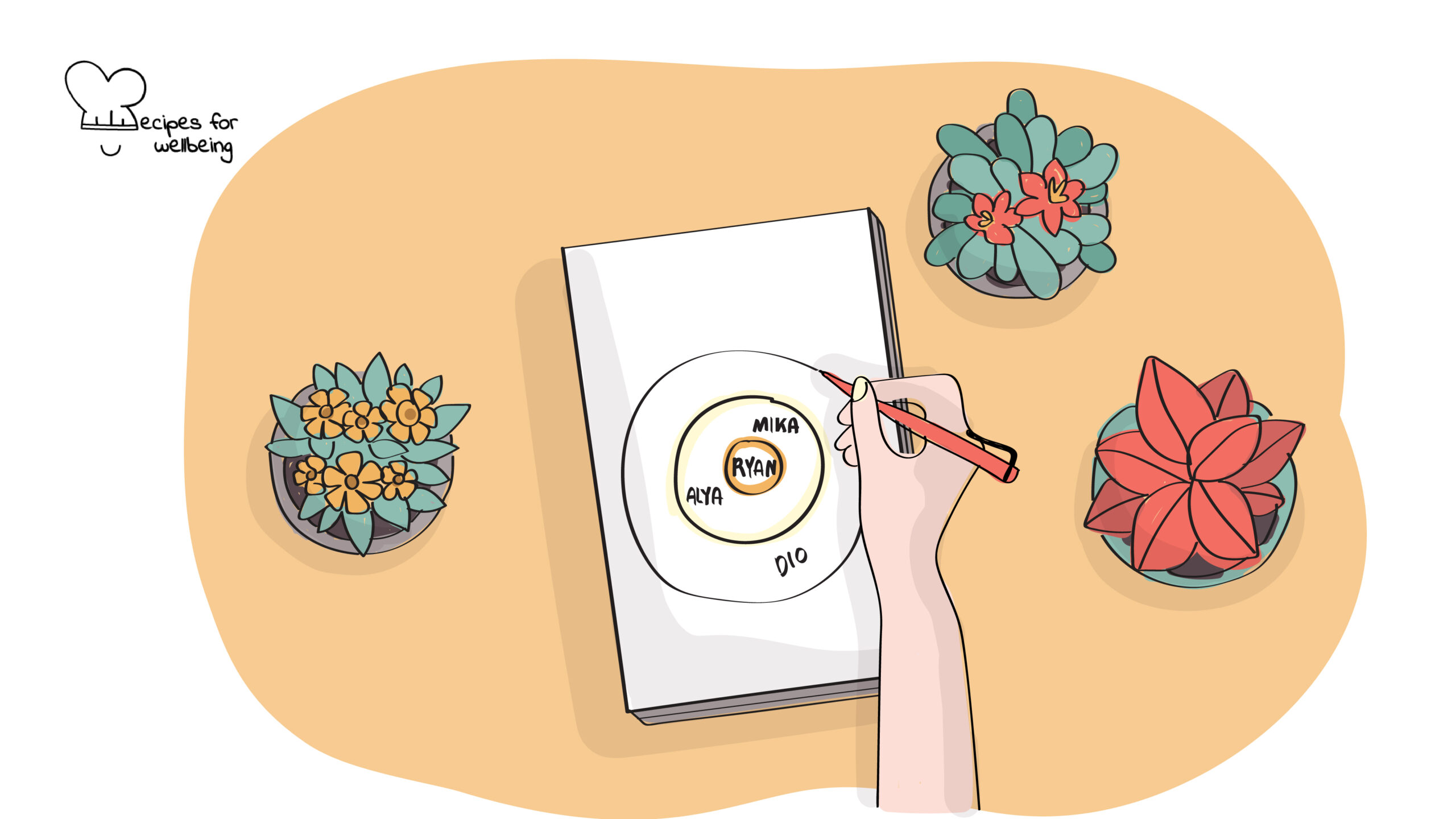
Ring theory
I learned that friendship isn’t only what you can give, it’s what you’re able to receive. ―Sheryl Sandberg
 Serves: 1 person
Serves: 1 person
 Difficulty: Medium
Difficulty: Medium
 Total time: Ongoing
Total time: Ongoing
 Ingredients: 1 sheet of paper, 1 pen, “Option B: Facing Adversity, Building Resilience, and Finding Joy” book by Sheryl Sandberg and Adam Grant (if you’re curious to find out more about it!)
Ingredients: 1 sheet of paper, 1 pen, “Option B: Facing Adversity, Building Resilience, and Finding Joy” book by Sheryl Sandberg and Adam Grant (if you’re curious to find out more about it!)
 Wholebeing Domains: Community, Radical Care
Wholebeing Domains: Community, Radical Care
 Wholebeing Skills: Allyship, Belonging, Caring, Closeness, Giving, Reciprocity, Relating to Others
Wholebeing Skills: Allyship, Belonging, Caring, Closeness, Giving, Reciprocity, Relating to Others

Ring theory
 Description
Description
Drawing your circle of support.
When you experience a personal tragedy, the pain does not derive only from the tragedy itself, but also from the feeling that your support system crumbles under your feet, leaving you with nothing to hold on to. You feel inadequate seeking support from others. And if it is your friend who has been affected by a personal tragedy, your well-intended empathy may lead to the inappropriate “quick-fixitis” syndrome. How can you learn to give or receive support at times of incredible pain?
This recipe has been inspired by the book Option B: Facing Adversity, Building Resilience, and Finding Joy, co-authored by Sheryl Sandberg and Adam Grant. In the process of healing from the loss of her husband, Sheryl Sandberg mentions the work of psychologist Susan Silk, who has created the “ring theory”. This is a simple technique around the basic idea of “comfort IN, dump OUT” that can work with all kinds of crises and you can read more about it in this article: “How not to say the wrong thing”.
•••
Important: We shared this recipe as part of our blog post “Wellbeing in the time of COVID-19” because it’s a useful activity to understand whom you can seek support from and who you should help out. Naturally, take all needed precautions: for instance, when talking to others, maintain at least 1 metre distance. We also shared it in our blog post “Wellbeing for Ukraine” and you can access a translated version here (kindly translated by our friend Yuliya Ielfimova).
 Steps
Steps
Step 1 – Draw a circle
Take a blank sheet of paper and a pen and draw a circle in the middle. This is the centre ring. In it, put the name of the person (or people) at the centre of the current trauma.
Step 2 – Draw concentric circles
Now draw a larger circle around the first one. In this ring, put the names of the people next closest to the trauma, the ones who are next most affected by the event. Keep drawing larger concentric circles for people based on their proximity to the crisis. Repeat the process as many times as you need to. Once you are done, you have a Kvetching Order.
Step 3 – Offer comfort in and seek comfort out
Look at your Kvetching Order and notice your position (you might be in the centre ring if you are the person most affected by the event, or perhaps one of your friends is while you occupy a more perimetral position). Here are the rules of engagement: the person in the centre ring can say anything they want to anyone, anywhere. Everyone else can say those things too, but only to people in larger rings, who are affected by the event to a lesser degree. On the other hand, when you are talking to a person in a ring smaller than yours, someone closer to the centre of the crisis, the goal is to console and help. Here, listening is often more helpful than talking. Refrain from giving advice, focus on comforting and supporting them. So say, “I’m sorry” or “This must be hard for you” or “Can I bring you a cup of tea?” instead of “You should hear what happened to me” or “Here’s what I would do if I were you”. The concept is simple: offer comfort to the ones in smaller circles than you and seek comfort from those in larger circles than you.


 Arabic
Arabic Chinese (Simplified)
Chinese (Simplified) Dutch
Dutch English
English French
French German
German Italian
Italian Portuguese
Portuguese Russian
Russian Spanish
Spanish